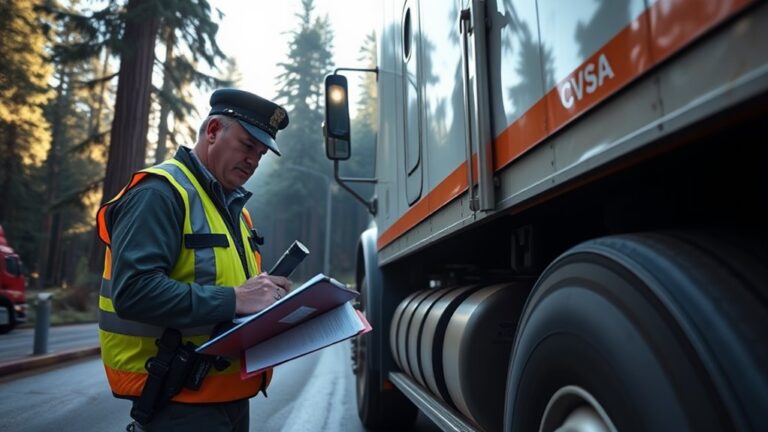As a law enforcement officer in Northern California, you’re tasked with ensuring road safety through CVSA inspections. Before you even step out of your patrol car, you need to have your equipment and documentation ready as well as you must know also CVSA roadside inspection steps. Approaching the driver, you’ll explain the inspection’s purpose clearly and professionally. But remember, the true challenge lies in the vehicle check—can you spot the subtle signs that something’s amiss? Stay tuned as we explore how to effectively document and manage these essential findings.

Preparing for the Inspection: Essential Equipment and Documentation
Before you begin a CVSA roadside inspection, it’s vital to confirm you have all the necessary equipment and documentation in order.
You’ll need your standard CVSA equipment, which includes the voice analysis device itself and compatible recording tools. Make sure you’re familiar with the operation of these tools, as they’re important for capturing accurate voice stress levels during your interviews.
Additionally, verify you have all required documentation ready. This includes your officer identification, any required warrants, and a checklist of CVSA procedures.
Being thoroughly prepared not only streamlines the process but also guarantees that the inspection adheres to legal standards.
Initial Approach and Driver Communication
Having confirmed your CVSA equipment and documentation are ready, you’ll next approach the vehicle and initiate communication with the driver.
Start by introducing yourself and explaining the purpose of the stop. You’ll want to keep your tone professional and calm to avoid escalating the situation.
Ask for their license and registration while observing their demeanor. Your training in voice stress analysis procedure will be essential here; listen carefully to vocal nuances that might indicate stress or deception.
This initial interaction sets the tone for the CVSA roadside inspection and helps you assess the driver’s reliability.
Conducting a Thorough Vehicle Safety Check
Once you’ve established communication with the driver, proceed to conduct a thorough vehicle safety check.
Begin by visually inspecting the vehicle’s exterior for any safety hazards such as damaged tires or malfunctioning lights. Confirm you verify the condition of brakes and mirrors thoroughly.
Next, move to the interior checks, focusing on seat belts, horn, and emergency equipment to confirm everything’s in working order.
During this process, utilize CVSA technology to maintain roadside truth verification, enhancing your ability to detect any discrepancies quickly.
This technology’s accuracy in field use will support your assessment, confirming you’re not just relying on visual cues but are backed by advanced verification methods.
This thorough approach confirms safety and compliance on the roads.
Documenting and Reporting Inspection Findings
After completing the CVSA and vehicle safety checks, it’s vital to document and report your findings accurately. As you record the details, apply the CVSA roadside interview techniques you’ve mastered. This includes noting any stress indicators detected during the assessment.
Your ability to perceive and document law enforcement stress detection is significant. Always use clear, precise language in your reports to guarantee they’re easily understood by others in your department.
Highlight any discrepancies or concerns that emerged during the interview, linking them back to specific vocal stress patterns observed. Remember, your detailed documentation not only supports potential legal proceedings but also helps in refining future inspections.
It’s about maintaining integrity and accountability in every step of your duty.
Managing Post-Inspection Procedures and Follow-Ups
With your inspection findings thoroughly documented, your next step is to manage the post-inspection procedures and assure effective follow-ups.
Make certain that all details are entered into the Northern California police technology systems promptly. This digital entry supports seamless communication and swift action.
If your CVSA results indicate discrepancies, schedule follow-up interviews or further investigations without delay. Your Northern California CVSA certification equips you with the guidelines necessary for these processes.
It’s essential to maintain transparency and accuracy during this phase to uphold the integrity of the findings.
Always keep involved parties informed about the status of their case, using the advanced tools at your disposal to enhance the efficiency and effectiveness of your follow-ups.
Frequently Asked Questions
How Accurate Is CVSA Compared to Traditional Polygraph Tests?
You’re comparing CVSA to traditional polygraphs, right? CVSA is generally less invasive and quicker but can vary in accuracy. It’s crucial to evaluate that it depends heavily on the operator and the context of use.
Can CVSA Results Be Used as Evidence in Court?
You’re wondering if CVSA results can be used as evidence in court. Generally, they aren’t admissible due to questions about their reliability compared to more established methods like polygraph tests. Always check local legal standards.
Are There Specific Times When CVSA Should Not Be Used?
You shouldn’t use CVSA during highly emotional or traumatic events, as stress levels can skew results. It’s also inappropriate when legal or ethical constraints prevent its application in sensitive or private situations.
How Does Weather Affect CVSA Test Results?
You’re likely wondering how weather impacts CVSA test results. Extreme conditions, like excessive heat or cold, can affect the equipment’s accuracy, making it vital to conduct tests in a controlled environment whenever possible.
What Training Is Required for Officers to Use CVSA Effectively?
To use CVSA effectively, you’ll need thorough training in vocal pattern analysis, ethical usage, and interpreting results accurately. This guarantees you’re equipped to apply the technology fairly and effectively during investigations.
Conclusion
You’ve mastered the CVSA roadside inspection steps, ensuring every protocol is closely followed in Northern California. By thoroughly preparing your equipment and effectively communicating with drivers, you maintain high standards of safety and compliance. Your meticulous checks and detailed documentation help keep the roads safe. Remember, each step—from initial approach to post-inspection follow-ups—is essential. Stay diligent and transparent in your reporting to uphold the integrity of your inspections and foster safer driving environments.
If you are looking for a highly skilled and accomplished lawyer based in Chico, California or nearby areas, you may want to check out Rooney Law Firm. They have an impressive track record of success in the legal field, having won over 95% of contested trials.
